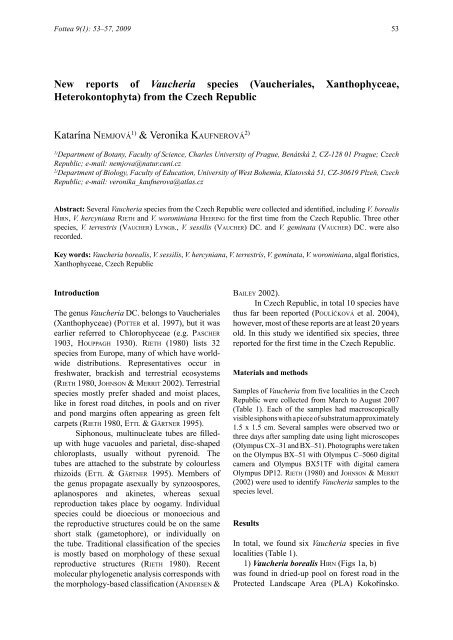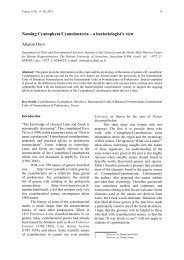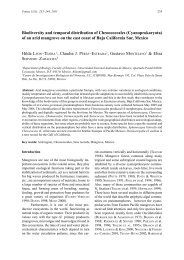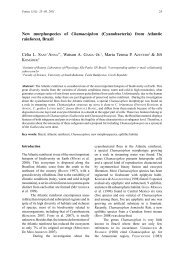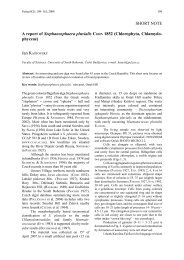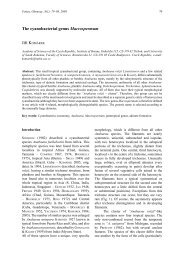New reports of Vaucheria species (Vaucheriales ... - Fottea
New reports of Vaucheria species (Vaucheriales ... - Fottea
New reports of Vaucheria species (Vaucheriales ... - Fottea
Create successful ePaper yourself
Turn your PDF publications into a flip-book with our unique Google optimized e-Paper software.
<strong>Fottea</strong> 9(1): 53–57, 2009 53<br />
<strong>New</strong> <strong>reports</strong> <strong>of</strong> <strong>Vaucheria</strong> <strong>species</strong> (<strong>Vaucheria</strong>les, Xanthophyceae,<br />
Heterokontophyta) from the Czech Republic<br />
Katarína Ne m j o v á 1) & Veronika Ka u f n e r o v á 2)<br />
1)<br />
Department <strong>of</strong> Botany, Faculty <strong>of</strong> Science, Charles University <strong>of</strong> Prague, Benátská 2, CZ-128 01 Prague; Czech<br />
Republic; e-mail: nemjova@natur.cuni.cz<br />
2)<br />
Department <strong>of</strong> Biology, Faculty <strong>of</strong> Education, University <strong>of</strong> West Bohemia, Klatovská 51, CZ-30619 Plzeň, Czech<br />
Republic; e-mail: veronika_kaufnerova@atlas.cz<br />
Abstract: Several <strong>Vaucheria</strong> <strong>species</strong> from the Czech Republic were collected and identified, including V. borealis<br />
Hi r n, V. hercyniana Ri e t h and V. woroniniana He e r i n g for the first time from the Czech Republic. Three other<br />
<strong>species</strong>, V. terrestris (Va u c h e r) Ly n g b., V. sessilis (Va u c h e r) DC. and V. geminata (Va u c h e r) DC. were also<br />
recorded.<br />
Key words: <strong>Vaucheria</strong> borealis, V. sessilis, V. hercyniana, V. terrestris, V. geminata, V. woroniniana, algal floristics,<br />
Xanthophyceae, Czech Republic<br />
Introduction<br />
The genus <strong>Vaucheria</strong> DC. belongs to <strong>Vaucheria</strong>les<br />
(Xanthophyceae) (Po t t e r et al. 1997), but it was<br />
earlier referred to Chlorophyceae (e.g. Pa s c h e r<br />
1903, Ho u p pa g h 1930). Ri e t h (1980) lists 32<br />
<strong>species</strong> from Europe, many <strong>of</strong> which have worldwide<br />
distributions. Representatives occur in<br />
freshwater, brackish and terrestrial ecosystems<br />
(Ri e t h 1980, Jo h n s o n & Me r r i t 2002). Terrestrial<br />
<strong>species</strong> mostly prefer shaded and moist places,<br />
like in forest road ditches, in pools and on river<br />
and pond margins <strong>of</strong>ten appearing as green felt<br />
carpets (Ri e t h 1980, Et t l & Gä rt n e r 1995).<br />
Siphonous, multinucleate tubes are filledup<br />
with huge vacuoles and parietal, disc-shaped<br />
chloroplasts, usually without pyrenoid. The<br />
tubes are attached to the substrate by colourless<br />
rhizoids (Et t l & Gä rt n e r 1995). Members <strong>of</strong><br />
the genus propagate asexually by synzoospores,<br />
aplanospores and akinetes, whereas sexual<br />
reproduction takes place by oogamy. Individual<br />
<strong>species</strong> could be dioecious or monoecious and<br />
the reproductive structures could be on the same<br />
short stalk (gametophore), or individually on<br />
the tube. Traditional classification <strong>of</strong> the <strong>species</strong><br />
is mostly based on morphology <strong>of</strong> these sexual<br />
reproductive structures (Ri e t h 1980). Recent<br />
molecular phylogenetic analysis corresponds with<br />
the morphology-based classification (An d e r s e n &<br />
Ba i l e y 2002).<br />
In Czech Republic, in total 10 <strong>species</strong> have<br />
thus far been reported (Po u l í č k o v á et al. 2004),<br />
however, most <strong>of</strong> these <strong>reports</strong> are at least 20 years<br />
old. In this study we identified six <strong>species</strong>, three<br />
reported for the first time in the Czech Republic.<br />
Materials and methods<br />
Samples <strong>of</strong> <strong>Vaucheria</strong> from five localities in the Czech<br />
Republic were collected from March to August 2007<br />
(Table 1). Each <strong>of</strong> the samples had macroscopically<br />
visible siphons with a piece <strong>of</strong> substratum approximately<br />
1.5 x 1.5 cm. Several samples were observed two or<br />
three days after sampling date using light microscopes<br />
(Olympus CX–31 and BX–51). Photographs were taken<br />
on the Olympus BX–51 with Olympus C–5060 digital<br />
camera and Olympus BX51TF with digital camera<br />
Olympus DP12. Ri e t h (1980) and Jo h n s o n & Me r r i t<br />
(2002) were used to identify <strong>Vaucheria</strong> samples to the<br />
<strong>species</strong> level.<br />
Results<br />
In total, we found six <strong>Vaucheria</strong> <strong>species</strong> in five<br />
localities (Table 1).<br />
1) <strong>Vaucheria</strong> borealis Hi r n (Figs 1a, b)<br />
was found in dried-up pool on forest road in the<br />
Protected Landscape Area (PLA) Kokořínsko.
54 Ne m j o v á & Ka u f n e r o v á: <strong>New</strong> <strong>reports</strong> <strong>of</strong> <strong>Vaucheria</strong> <strong>species</strong><br />
Thalli were 50–85 µm wide. Oogonial dimensions<br />
were 61–97 x 94–121 µm and hooked anteridia<br />
were 25–35 µm wide. This represents the first<br />
report <strong>of</strong> this <strong>species</strong> for the Czech Republic.<br />
2) <strong>Vaucheria</strong> geminata (Va u c h e r) DC.<br />
(Figs 1c, d, e)<br />
was found on the margin <strong>of</strong> an oxbow lake <strong>of</strong><br />
the upper Lužnice river near by Nová Ves nad<br />
Lužnicí in South Bohemia. Vegetative filaments<br />
were 40–51 µm wide, oogonial size were 33–56<br />
µm x 44–73 µm. The central hooked antheridia<br />
were never longer than lateral oogonia and their<br />
width was 16–26 µm. Oogonia were mostly in<br />
the opposite position. Other record <strong>of</strong> this <strong>species</strong><br />
is from the Nesyt pond near Lednice na Moravě<br />
town (Ko m á r k o v á et al. 1983).<br />
3) <strong>Vaucheria</strong> hercyniana Ri e t h (Figs 2a, b)<br />
was collected on a soil surface on the margin <strong>of</strong><br />
a dry puddle on a forest path near a pond close<br />
to the Lednice na Moravě town. The unstalked<br />
antheridia and pairwise reproductive structures at<br />
the end <strong>of</strong> filament were the main discriminative<br />
features for the identification <strong>of</strong> this <strong>species</strong>.<br />
Filaments were 38.5–55 µm wide. Oogonia were<br />
almost spherical with dimensions 88–94 x 88–104<br />
µm. Dimensions <strong>of</strong> the antheridia were 70–73 x<br />
49–54 µm. Aplanospores were also observed and<br />
they were 68–76 µm wide and 92–95 µm long.<br />
This represents the first report <strong>of</strong> this <strong>species</strong> from<br />
the Czech Republic.<br />
4) <strong>Vaucheria</strong> sessilis (Va u c h e r) DC.<br />
(Figs 2c, d)<br />
was found in České Středohoří PLA on the river<br />
margin Granátka near by Dřevce. Width <strong>of</strong> the<br />
filaments ranged between 50–60 µm, oogonial<br />
dimensions were 70–80 x 95–115 µm and<br />
antheridia 25–30 µm wide. This <strong>species</strong> was<br />
several times reported from different places across<br />
the Czech Republic (Jablonec nad Nisou, Stříbro,<br />
Praha, Rokycany, Rychnov, Tanvald, Velký Osek,<br />
Dukovany, Ludkovice, Šumava, Plzeň - Pa s c h e r<br />
1903, Po u l í č k o v á et al. 2004).<br />
5) <strong>Vaucheria</strong> terrestris (Va u c h e r) Ly n g b.<br />
(Figs 2e, f)<br />
was found in the same locality as V. sessilis.<br />
Filaments were 50–55 µm wide, oogonia<br />
dimensions were 80–90 x 100–105 µm and<br />
antheridia were 25–30 µm wide. The population<br />
examinated could be classified as V. terrestris var.<br />
nuoljae Sk u j a (Ri e t h 1980). This <strong>species</strong> was also<br />
reported from Kounov (Po u l í č k o v á et al. 2004),<br />
about 30 km from our locality in Dřevce.<br />
6) <strong>Vaucheria</strong> woroniniana He e r i n g<br />
(Fig. 1f)<br />
was collected from a moist forest track in<br />
the surroundings <strong>of</strong> Mostov village (North<br />
Bohemia). Reproductive structures were similar<br />
to V. geminata, but the terminal antheridium<br />
consistently overlapped the two lateral oogonia,<br />
which is considered to be crucial discriminating<br />
feature <strong>of</strong> this <strong>species</strong> (Ri e t h 1980). The antheridia<br />
had two lateral pores. The width <strong>of</strong> the antheridia<br />
was 47–50 µm. Oogonia were oval without any<br />
papilla and their dimensions ranged between<br />
53.5–62 x 76–82 µm. The filaments (about 30 µm)<br />
were narrower than generative branches (width<br />
about 40 µm). The population examinated is the<br />
nominate variety, V. woroniniana f. woroniniana<br />
(Ri e t h 1980). This represents the first report <strong>of</strong><br />
this <strong>species</strong> from the Czech Republic.<br />
Table 1. List <strong>of</strong> found <strong>species</strong> and their localities<br />
<strong>species</strong> sampling locality altitude GPS<br />
date<br />
V. borealis 17. 3. 2007 PLA Kokořínsko, Dolní Zimoř 200 m a. s. l. 50°25‘43.957“N 14°30‘33.74“E<br />
V. geminata 12. 8. 2007 Nature Reserve Horní Lužnice, 474 m a. s. l. 48°49‘14.27“N 14°55‘58.01‘‘E<br />
Nová Ves nad Lužnicí<br />
V. hercyniana 4. 6. 2007 Lednice na Moravě, Lednice 175 m a. s. l. 48°46‘51.857“N 16°48‘13.243“E<br />
pond<br />
V. sessilis 1. 5. 2007 PLA České Středohoří, Dřevce, 600 m a. s. l. 50°29‘41.097“N 13°52‘35.054“E<br />
river Granátka<br />
V. terrestris 1. 5. 2007 PLA České Středohoří, Dřevce, 600 m a. s. l. 50°29‘41.097“N 13°52‘35.054“E<br />
river Granátka<br />
V. woroniniana 7. 8. 2007 forest near the village Mostov 420 m a. s. l. 50°6‘46.243“N 12°29‘27.667“E
<strong>Fottea</strong> 9(1): 53–57, 2009 55<br />
Discussion<br />
Traditional taxonomy <strong>of</strong> the genus <strong>Vaucheria</strong><br />
DC. is based on morphology <strong>of</strong> their reproductive<br />
structures and this morphological classification<br />
corresponds with molecular data (An d e r s e n<br />
& Ba i l e y 2002). The widespread opinion that<br />
<strong>Vaucheria</strong> populations are hard to determine to<br />
subgeneric levels in nature is based on findings <strong>of</strong><br />
sterile filaments. However, for all <strong>of</strong> the six <strong>species</strong><br />
in this study, we were able to find the reproductive<br />
structures growing in natural conditions. This<br />
may not be considered as exception, because<br />
e.g., Ze l a z n a-Wi e c z o r e k (2002) also reported<br />
that spring <strong>Vaucheria</strong> populations usually have<br />
highest frequence <strong>of</strong> reproductive structures. Cooccurence<br />
<strong>of</strong> several <strong>Vaucheria</strong> <strong>species</strong> certainly<br />
is a problem for determining which <strong>species</strong> are<br />
present in natural habitats. Caution and careful<br />
examination <strong>of</strong> higher number <strong>of</strong> specimens from<br />
any sample is necessary for correct determination<br />
<strong>of</strong> all present <strong>species</strong>.<br />
Many <strong>species</strong> <strong>of</strong> <strong>Vaucheria</strong> have<br />
cosmopolitan distributions, but a few <strong>species</strong> have<br />
been only once reported in the literature (e.g. V.<br />
birostris J. Si m o n s in Ri e t h 1980). Uncommon<br />
occurrence <strong>of</strong> a few <strong>species</strong> could potentially be<br />
caused by their restricted distributions, or their<br />
generally low abundance and a small population<br />
sizes. <strong>Vaucheria</strong> sessilis, V. borealis, V. geminata<br />
and V. woroniniana belong to frequently reported<br />
members <strong>of</strong> the genus (Ri e t h 1980). On the other<br />
hand, V. terrestris var. nuoljae was so far only<br />
reported from Lappland (Abisko) (Ri e t h 1980).<br />
<strong>Vaucheria</strong> hercyniana was reported only once<br />
from Harz Mts. in Germany (Ri e t h 1980). Thus,<br />
our locality near the Lednice na Moravě town is<br />
the second locality ever reported for this <strong>species</strong>.<br />
In several <strong>Vaucheria</strong> <strong>species</strong>, substratum<br />
preferences have been reported. <strong>Vaucheria</strong><br />
terrestris typically occurs in subaerophytic mats<br />
together with V. sessilis and other filamentous<br />
algae (e.g. Tribonema, Spirogyra, Mougeotia and<br />
Zygnema) on soil surfaces on the margins <strong>of</strong> rivers<br />
and pools (Ri e t h 1980), which perfectly concurs<br />
with our data. <strong>Vaucheria</strong> hercyniana was reported<br />
from ephemeral microhabitats (Ri e t h 1980) and<br />
we also found this <strong>species</strong> on a wet soil surface on<br />
the margin <strong>of</strong> an ephemeral puddle.<br />
Even if <strong>Vaucheria</strong> <strong>species</strong> are widely<br />
distributed and they frequently occur in the central<br />
European landscape, we still do not have sufficient<br />
data on their autecology and biogeography. In this<br />
respect, we believe that further floristic research<br />
on this ecologically important genus is needed.<br />
Acknownledgement<br />
We thank RNDr. Jiří Neustupa, PhD. for reading<br />
the manuscript and worthful advices and Mgr.<br />
Petra Vágnerová for taking the sample from České<br />
Středohoří.<br />
References<br />
An d e r s e n, R.A. & Ba i l e y, J.C. (2002): Phylogenetic<br />
analysis <strong>of</strong> 32 strains <strong>of</strong> <strong>Vaucheria</strong><br />
(Xanthophyceae) using the rbcL gene and<br />
its two flanking spacer regions. – Journal <strong>of</strong><br />
Phycology 38: 583–592.<br />
Et t l, H. & Gä rt n e r, G. (1995): Syllabus der Boden-,<br />
Luft- und Flechtenalgen. – pp. 222–235, Gustav<br />
Fischer Verlag, Jena <strong>New</strong> York.<br />
Ho u p pa g h, K.W. (1930): A taxonomic study <strong>of</strong> <strong>species</strong><br />
<strong>of</strong> the genus <strong>Vaucheria</strong> collected in California.<br />
– American Journal <strong>of</strong> Botany 17: 329–347.<br />
Jo h n s o n, L.R. & Me r r i t, R. (2002): Order <strong>Vaucheria</strong>les.<br />
– In Jo h n, D.M., Wh i t t o n, B.A. & Br o o k, A.J.<br />
(eds): The freshwater Algal Flora <strong>of</strong> British<br />
Isles. – pp. 261–270, Cambridge University<br />
Press.<br />
Ko m á r k o v á, J., Ma rva n, P., Ry č k o v á, M.A. (1983):<br />
Pervičnaja produkcijai rol´vodorostej v litoralnoj<br />
zone vodoemov različnogo tipa. – In: Ra s p o p o v<br />
& He j n ý, S. (eds): Gidrobiologičeskije processy.<br />
– pp. 91–105, Nauka Lenigradskoe otdelienie,<br />
Leningrad.<br />
Pa s c h e r, A. (1903): Zur Algenflora des südlichen<br />
Bohmerwaldes. – Lotos 23: 161–211.<br />
Po t t e r, D., Sa u n d e r s, G.W., & An d e r s e n, R.A.<br />
(1997): Phylogenetic Relationships <strong>of</strong> the<br />
Raphidophyceae and Xanthophyceae as<br />
Inferred from Nucleotide Sequences <strong>of</strong> the 18S<br />
Ribosomal RNA Gene. – American Journal <strong>of</strong><br />
Botany 84: 966–972.<br />
Po u l í č k o v á, A., Lh o t s k ý, O. & Dř í m a l o v á, D. (2004):<br />
Prodromus sinic a řas České republiky. – Czech<br />
Phycology 4: 19–33.<br />
Ri e t h, A. (1980): Xanthophyceae 2. Teil. – In Et t l, H.,<br />
Ge r l o f f, J. & He y n i g, H. (eds): Süsswasserflora<br />
von Mitteleuropa, Band 4. – 147 pp., VEB<br />
Gustav Fischer Verlag, Jena.<br />
Ze l a z n a-Wi e c z o r e k, J. (2002): <strong>Vaucheria</strong> <strong>species</strong> from<br />
selected regions in Poland. – Acta Societatis<br />
Botanicorum Poloniae 71: 129–139.<br />
© Czech Phycological Society<br />
Received February 10, 2008<br />
Accepted April 29, 2008
56 Ne m j o v á & Ka u f n e r o v á: <strong>New</strong> <strong>reports</strong> <strong>of</strong> <strong>Vaucheria</strong> <strong>species</strong><br />
Fig. 1. (a, b) <strong>Vaucheria</strong> borealis Hi r n: (a) oogonium, (b) antheridium and oogonium, scale bar 40 µm; (c–e) V. geminata<br />
(Va u c h e r) DC.: (c) generative branch with central antheridium and two oogonia, scale bar 40 µm, (d) generative branch with<br />
central antheridium, scale bar 40 µm, (e) generative branch with central antheridium and two oogonia, scale bar 25 µm; (f) V.<br />
woroniniana He e r i n g generative branch with central antheridium and two oogonia, scale bar 40 µm.
<strong>Fottea</strong> 9(1): 53–57, 2009 57<br />
Fig. 2. (a, b) <strong>Vaucheria</strong> hercyniana Ri e t h: (a) oogonium and sacks antheridium, (b) oogonium, scale bar 40 µm; (c, d) V. sessilis<br />
(Va u c h e r) DC.: (c) oogonium, scale bar 20 µm, (d) empty antheridium, scale bar 30 µm; (e, f) <strong>Vaucheria</strong> terrestris (Va u c h e r)<br />
Ly n g b.: (e) antheridium and oogonium, scale bar 70 µm, (f) antheridium and oogonium, scale bar 30 µm.
Phycological Workshop in Rožmberk nad Vltavou, 2008.


